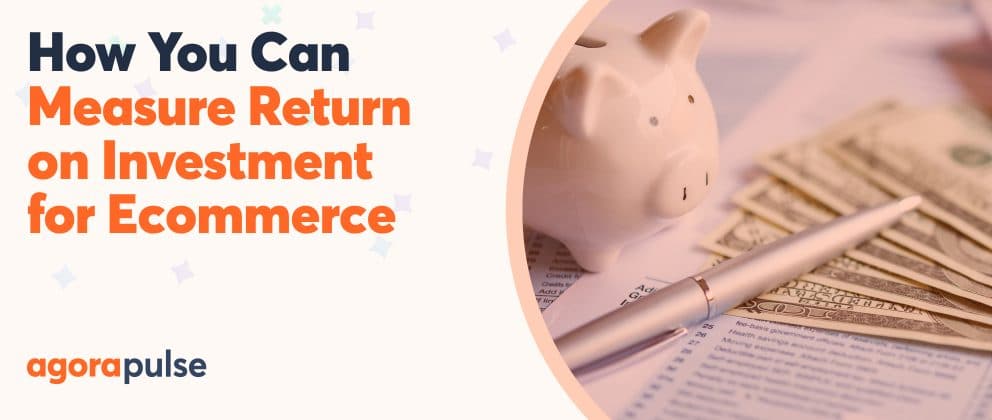If you manage social media marketing for an ecommerce business or client, then measuring ROI (or return on investment) is essential. Tracking ROI lets you assess the value of your marketing efforts and helps you understand what’s driving the best (or worst) results.
Find out how to measure ecommerce ROI so you can analyze your efforts, improve your social media marketing strategy, and launch more successful advertising campaigns.
What Is Ecommerce ROI?
Ecommerce ROI measures the profit from a marketing campaign or channel. It compares the amount you spent on the initiative to the amount you earned from it.
It’s expressed as a percentage, and it can be positive or negative.
A positive ROI indicates a profit, and a negative ROI reflects a loss—signaling that you spent more than you earned.
Why You Need to Know Your Ecommerce ROI
For ecommerce marketers, ROI is a critical metric.
Let’s look at the key ways your team or clients can benefit from tracking it.
Identify your top marketing campaigns
You probably feel confident reporting on individual social media marketing campaigns. But comparing multiple types of initiatives isn’t easy, especially if you need to consider paid and organic campaigns with varying structures and outcomes.
When you track ROI, you can use a single calculation to determine success and pinpoint top-performing campaigns.
Once you know what works best for your business, you can continue to run effective promotions that meet or exceed your marketing goals.
Test new marketing channels and initiatives
If you’ve already found success with one marketing channel, you might be tempted to stick with it. Over time, you could become dependent on a single channel or miss lucrative opportunities to adopt other platforms.
When you benchmark ROI, you can easily test new channels and evaluate results efficiently. That way, you can keep trying new tactics without wasting a ton of ad spend or missing something big.
Grow your ecommerce business
The more you know about your ecommerce ROI, the easier it is to grow your business. Once you identify what works, you can scale successful campaigns to generate more revenue or reallocate ad spend from less effective channels.
For best results, continue tracking the return from your marketing campaigns every week or month. That way you can continue to increase ROI and boost your bottom line.
Discover how to rock ecommerce at our FREE summit on Dec. 15!
How to Calculate Return on Investment in Ecommerce
There are two standard ways to calculate ecommerce ROI. The more basic option gives you a solid overview, while the advanced formula offers more nuance—but requires more data.
Basic ecommerce ROI calculation
Here’s a simple way to check the success of your team’s marketing efforts:
ROI = (Profit / Investment) – 1
How would this ROI formula apply in a hypothetical scenario?
Say you’ve been promoting a new product for the past month. You spent $500 on Facebook ads and $2,500 on blog posts.
The ad campaign generated fiv new customers, and organic traffic led to 50 new customers. Assume the average order value (AOV) was $75 for all customers.
Plug the numbers into the ROI formula to measure each channel separately. In this hypothetical scenario, the ROI for Facebook ads is -25%, while the ROI for blog content is 50%.
Based on this calculation, it would be easy to conclude that Facebook ads aren’t worth the spend—but blog posts and organic search may be worth a bigger investment. But before you pause your ad spend and focus on content marketing, it’s important to look at the bigger picture.
Advanced ecommerce ROI calculation
The basic ROI formula above reflects customers’ first purchases only. But for most successful ecommerce businesses, the first purchase is only the beginning of the relationship.
That’s why it’s so important to consider the full value of the customer relationship when calculating ROI.
When you can anticipate your customer lifetime value (CLV), you can calculate how much revenue all those online shoppers will generate over time.
Here’s how to use CLV data to do an advanced ecommerce ROI calculation:
ROI = (CLV / Investment) – 1
For many businesses, CLV varies from channel to channel, making it useful to calculate ROI for each channel separately. To continue the example above, use the same numbers to start. Then factor in average customer values of $150 for organic traffic and $1,000 for Facebook ads.
The ROI from Facebook ads is 900%, while the ROI from organic traffic is 50%. Although there’s no change to the ROI from organic traffic, the ROI from Facebook ads increases dramatically.
Although it initially seemed like Facebook ads weren’t as useful of an investment, factoring in CLV reveals the opposite. With CLV data at your fingertips, you’d be able to make a much smarter decision for your business.
In some cases, you may not be able to segment CLV data per channel. After all, calculating CLV for each channel requires a deep dive into your ecommerce database or customer relationship management (CRM) tool.
If calculating separate metrics proves too challenging, you can still use an average CLV to understand how your investment is likely to pay off over time. Then you can use the data to make the best marketing strategy decisions for your organization or client.
Where to Find Ecommerce ROI Metrics
Unless you have a custom enterprise-level ecommerce dashboard, you’ll have to do a little digging to find the data you need for these calculations.
Here’s where to check.
Ecommerce dashboard
Whether you use Shopify, BigCommerce, or another ecommerce platform, your dashboard should have detailed data on your customers’ purchasing patterns. In many cases, you can create custom reports and dashboards to access metrics quickly.
Here are a few you’ll need:
- Total revenue
- Number of orders
- Number of customers
Using these metrics, you can calculate AOV and purchase frequency, which you’ll need to determine CLV. Here are the formulas to use:
AOV = Total Revenue / Total Number of Orders
Purchase Frequency = Total Number of Orders / Total Number of Customers
CLV = AOV x Purchase Frequency
Website analytics
Web analytics apps like Google Analytics collect many common ecommerce metrics automatically. To start monitoring them, open the Google Analytics admin panel and enable ecommerce tracking and reporting.
To access a marketing channel breakdown, click the Acquisition tab and select Overview. You can view the number of transactions, the revenue amount, and even the conversion rate for each channel.
For more granular detail, click any marketing channel and toggle the primary dimension.
Here are a few ways to identify the specific customer acquisition efforts that drove conversions and revenue.
- Organic: Sort by Landing Page to see how much revenue each blog post or product page drove.
- Social: Select a social network, and then sort by campaign to see metrics for each. To see campaign-level breakdowns, you have to set up UTM parameters when creating an ad campaign or organic post.
- Email: Sort by campaign to find top performers.
- Google Ads: Use the Google Ads integration to view conversions, revenue, and other results for each pay-per-click (PPC) campaign.
Advertising platform
For accurate advertising metrics, it’s best to check the platform where you’re running the campaign.
If you’ve set up the platform’s advertising pixel, then the conversion data should sync with your ecommerce site. Platforms to check include …
- Facebook Ads Manager
- Google Ads
- LinkedIn Campaign Manager
- Pinterest Ads
- Twitter Ads
Internal database
By now, you should have most of the data you need for tracking ecommerce ROI. But if you’ve hired contractors to write blog posts, manage search engine optimization (SEO), or create other content, then you may also need to check internal databases to find relevant costs.
What Is Good ROI for Ecommerce?
Because so many factors affect ecommerce marketing, ROI can vary significantly. Marketing channels, revenue margins, and even business stage can impact your return. That means there’s no specific percentage that’s considered the gold standard for ecommerce ROI.
So how so you know what’s good—and how can you measure the success of your ecommerce marketing efforts? Benchmarking your ROI is a great way to keep track of your results. When you benchmark results for your company or clients, you can continue to improve your return over time—and know when it’s time to change tactics.
To set ecommerce ROI benchmarks, start by calculating your return for a specific campaign or channel. Then recalculate ROI for the same campaign or channel once a month.
Chart the results and look for patterns:
- If your ecommerce ROI for a certain channel has increased gradually or spiked suddenly, now could be the ideal time to lean into the channel or scale the campaign.
- In contrast, if the ROI has decreased, you may need to revisit your ecommerce marketing strategy or test new channels or campaigns.
7 Ways to Increase Ecommerce ROI
Whether you want to optimize your ecommerce ROI or you need to recover a declining rate, you can try several different strategies. Here are seven ways you can improve your ROI.
1. Create more compelling content
It’s easy to assume that publishing high-quality content will drive interested customers to your website. But just because a blog post is well-written and packed with your brand’s unique take doesn’t mean it will succeed at attracting traffic or converting site visitors.
Fortunately, you don’t have to guess what kind of content your customers want to see. You can use free tools like Google Analytics or Google Search Console to see the top search queries that drive traffic to your website.
You can also use paid SEO tools like Moz or SEMrush to identify the most helpful keywords to target. As you optimize your website content for major keywords, you can track the search queries and landing pages that drive the most conversions and the lowest bounce rate.
When you create new content for your ecommerce site, always keep your buyer persona in mind. The more you personalize your content and speak to your ideal customer, the better chance you have to convert site visitors.
2. Put your ecommerce data to work
Does it seem like the targeting parameters for your marketing campaigns aren’t granular enough? Google Analytics and your ecommerce dashboard can provide much more than keyword and conversion data alone. Use your dashboards to source data like:
- Locations, including city, state, and region
- Device usage, including desktop or mobile
- Interests and purchase intents
You can use data from your current customers to attract more online shoppers like them. Using these insights, you can fine-tune your buyer persona and create more personalized content. You can also build more relevant audience targeting for your ad campaigns.
3. Improve your sales funnel
In many cases, a single blog post or social ad won’t be enough to convert new customers. Instead, you may need to create multiple touchpoints for prospective customers. If you can guide them through your sales funnel, you may be able to convert them successfully.
To improve your existing sales funnel or create a new one, map out content and messaging for each stage—from awareness and consideration to conversion and loyalty. Then use all the tools and channels at your disposal to amplify your remarketing and lead nurturing efforts.
With remarketing and nurturing tactics, you can reengage people who have already shown interest in your business or offer. That way you can decrease customer acquisition costs and increase ROI. Here are a few ideas for your funnel:
- Encourage prospects to follow your business on social media so you can continue to reach them organically.
- Ask people to sign up for your email list so you can send them targeted offers.
- Add people to remarketing audiences and target them with PPC or paid social ads.
4. Test new campaigns and channels
Have the recent changes to Facebook ad targeting caused your results to take a nose dive? Rather than continuing to optimize your Facebook ads, consider testing a new type of campaign or a new channel.
For example, traffic and conversion Facebook ad objectives might not be delivering the results you want. You might try experimenting with the catalog sales campaign, or you might test Pinterest ads or PPC campaigns instead.
As you branch out into different channels and tactics, closely monitor the ROI for each. Keep in mind metrics may fluctuate a lot in the first days or a new campaign or weeks of a new channel. Once they even out, you can make data-backed decisions about the best marketing strategy for your business.
5. Rethink your offer
Are your marketing campaigns failing to drive enough traffic to your product or landing pages? It may be time to rethink your offer. Here are a few ways to make it more compelling and improve ROI at the same time:
- Provide a discount or promo code
- Create a sense of urgency with a limited-time sale
- Elicit a fear of missing out with a limited product run
6. Optimize product and landing pages
Are your marketing campaigns driving tons of traffic to your website—yet still resulting in low conversion rates? The messaging in your ads, social posts, or emails may be spot on. But the linked landing pages may not be designed to maximize conversions.
To improve your product pages, consider:
- Testing site speed to ensure each page loads within a couple of seconds
- Reviewing the payment process to identify points of friction
- Adding customer testimonials or user-generated content (UGC) as social proof
To optimize landing pages, think about:
- Removing unnecessary content and features to focus on the offer
- Changing the layout to make it simpler or more mobile-friendly
- Ensuring the messaging on the landing page, ad, and email all align
7. Increase customer loyalty
Attracting new customers can be a difficult and expensive process. If decreasing acquisition costs is proving too challenging, consider focusing on your existing customer metrics instead.
In other words, encourage customers to make multiple purchases over time. For example, your ecommerce store may cross-sell related products, upsell pricier versions of a product, or sell consumable products at regular intervals.
By improving customer loyalty, you can increase CLV and enhance ROI. Here are a few ideas for encouraging customers to make repeat purchases:
- Engage with loyal customers and feature their UGC on social media
- Retarget loyal customers with special discounts via email or social media
- Launch a customer loyalty program to increase purchase frequency
What We Learned About Ecommerce ROI
For ecommerce businesses and agencies, knowing how to measure ROI is essential. Knowing how to improve this metric is even more important. With these tips, you can calculate and track ecommerce ROI effectively as you continue to increase your clients’ or organization’s return on investment.
Get started on saving time and energy on your own social media management! Check out our free trial of Agorapulse to help you schedule, track, and measure all your social media efforts.





